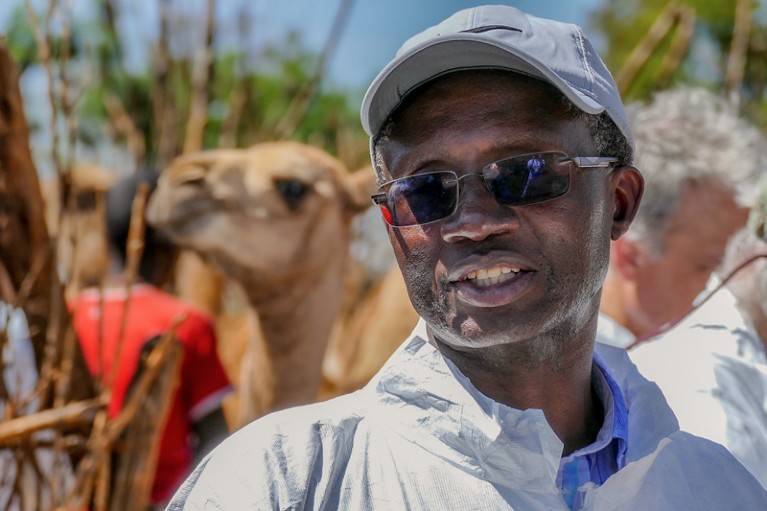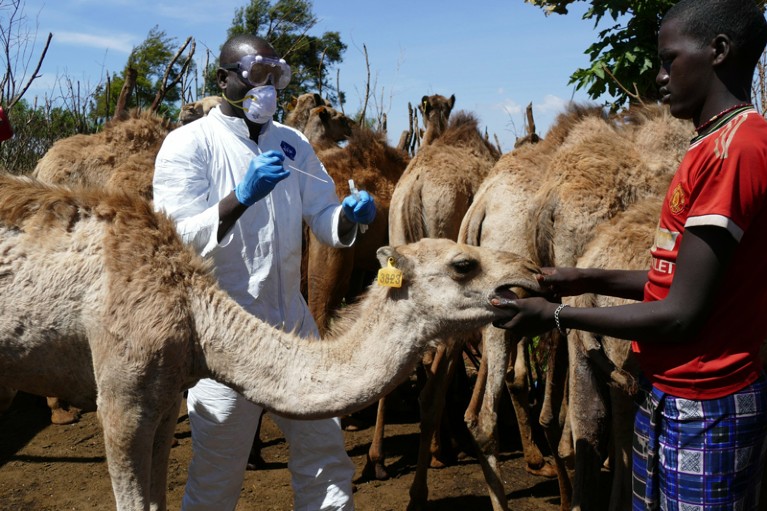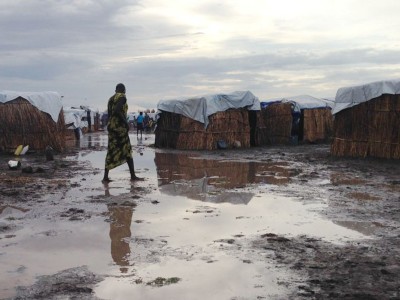
Kariuki Njenga is building up capacity to study emerging infectious diseases in Africa.Credit: Washington State University College of Veterinary Medicine
Virologist Kariuki Njenga studies emerging zoonotic diseases such as Rift Valley Fever and swine flu in sub-Saharan Africa in his role as chief research officer at the Kenya Medical Research Institute (KEMRI) in Nairobi — a post he combines with being professor of infectious diseases at Washington State University (WSU) in Pullman. Nature speaks to him about his work and views on ensuring that Africa prepares for the next pandemic.
How do you balance your time between the WSU and KEMRI?
I am a professor at the WSU, but I am not required to teach a lot there: I just lead the research in Kenya. This means I do not need to travel frequently back to Washington. The WSU collaborates with local universities such as the University of Nairobi in Kenya, where I supervise students.
I am based full-time in Nairobi, mostly working daily with KEMRI to fulfil the research goals of the WSU. Under the terms of my contract with the WSU, I supervise PhD students at the University of Nairobi, collaborate with other faculties there, and write grant applications to bring funding to the institution. While at KEMRI, I form part of the team that addresses the most pertinent public-health issues affecting the Kenyan people.
My goal is to make WSU Global Health — Kenya, which represents the institution’s public-health mission in Kenya, the go-to place for cutting-edge research in emerging infectious diseases on the continent. This will be achieved through training and mentorship, so that long after this generation of researchers is gone, there will be others to take over. This is an especially important task here: East and Central Africa is where many of these infectious diseases originate.
Tell us about your work in Africa
In early 2019, a request came from the US National Institute of Allergy and Infectious Diseases (NIAID) for applications to help establish a global network called the Centers for Research in Emerging Infectious Diseases (CREID). Ten centres were established around the world. I recruited a team of scientists in East and Central Africa, with myself as the principal investigator, and we applied to set up and run the centre in charge of this region. The CREID network’s aim is to investigate how viruses and pathogens emerge from wildlife and spill over to humans, leading to diseases.
Career resources for African scientists
Our job is to ask the right research questions to prevent disease outbreaks in East and Central Africa, and we currently have field studies going on in Kenya, Uganda, Tanzania and the Democratic Republic of the Congo (DRC).
I lived in the United States full-time from 1990, but came back to Kenya in 2004 to study emerging zoonotic diseases — which include Rift Valley fever, swine flu and Ebola — and to apply for grants from international organizations. From 2004 to 2014, I was working with the US Centers for Disease Control and Prevention as the head of labs, and in other roles touching on its One Health programme in Kenya, and would travel between the two countries when needed.
Why are emerging infectious diseases prevalent in this region of Africa?
Diseases that come from wildlife account for more than 65% of all emerging infectious diseases. In East and Central Africa, a huge diversity of animals live in the Congo rainforest, where they’re hunted by a growing population of local people.
Rare pathogens in those animals could jump between wildlife into humans, often through a livestock intermediary, and cause deadly disease outbreaks. Although the COVID-19 pandemic did not originate in Africa, our region is a hotspot for emerging infectious diseases because of the range of wildlife and the number of human–wildlife interactions.
Have you done research on coronaviruses before?
We have ongoing research on the Middle East respiratory syndrome coronavirus (MERS-CoV) in northern parts of Kenya. First reported in humans in 2012, MERS-CoV was initially transmitted to humans through dromedary camels (Camelus dromedarius) and continues to cause human infections and deaths. More than 80% of the world’s dromedary camels are here in Africa.

A researcher tests a camel in Marsabit, Kenya, for the coronavirus behind Middle East respiratory syndrome.Credit: Washington State University College of Veterinary Medicine
How will you combat infectious diseases in the future in Africa?
First, we are establishing field studies in areas where there’s potential for pathogens to spill over from wildlife to humans, so that we can detect viruses and pathogens among animals. We already have research facilities in some high-risk areas, including in Goma, the capital of North Kivu province in the eastern part of the DRC, close to the Congo Basin. Another site is located in western Uganda, and there’s another in northern Kenya.
These places are where we see a lot of contact between humans and livestock or wildlife, and they might have a history of a disease such as Rift Valley fever. Our primary aim is to conduct research that will serve as an early-warning system, so that when a virus is detected, we can take protective measures before it spills over to humans and causes a pandemic.
Second, if we get a disease outbreak before detecting a virus, we hope to develop diagnostics for testing as soon as possible.
When the coronavirus pandemic broke out, researchers sequenced the SARS-CoV-2 virus in less than 10 days. That’s a great example of what we want to do: shorten the time taken to detect pathogens and sequence viruses.
Lessons learnt from doing research amid a humanitarian crisis
Finally, we will provide immunotherapeutics, including vaccines and drugs against viruses. The CREID network has expertise in developing vaccines and therapeutics, both directly in certain centres, and through a number of collaborating biomedical companies. Our plan is that when a new virus is detected and sequenced, this information will be provided to our partners and collaborating industries so that they can start developing therapeutics and vaccines.
What does Africa need to do to prepare against the next pandemic?
African governments need to empower the Africa Centers for Disease Control and Prevention, a specialized technical institution administered by the African Union — Africa’s apex continental institution — to build countries’ capacity in developing diagnostics and vaccines. That’s the first, immediate step. Then we need to establish emerging-infectious-disease centres similar to those that make up CREID — but managed and funded by African governments — in other regions of the continent.
These are the steps we need to take to ensure that future pandemics do not leave us dependent on the international community for help. We have seen how supply chains can collapse when countries face existential threats such as COVID-19, deepening existing inequalities — we need to be able to protect ourselves independently.

 Lessons learnt from doing research amid a humanitarian crisis
Lessons learnt from doing research amid a humanitarian crisis
 Has COVID taught us anything about pandemic preparedness?
Has COVID taught us anything about pandemic preparedness?
 Wanted: rules for pandemic data access that everyone can trust
Wanted: rules for pandemic data access that everyone can trust







